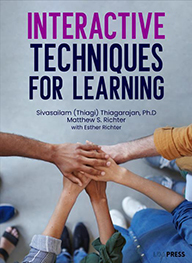- Home
- Articles
- Reviews
- About
- Archives
- Past Issues
- The eLearn Blog
Archives
| To leave a comment you must sign in. Please log in or create an ACM Account. Forgot your username or password? |
|
Create an ACM Account |

Too often, interactive learning is dismissed as mere entertainment—something designed to keep students engaged but lacking real instructional value. Interactive Techniques for Learning (BookBaby, 2024) by Sivasailam Thiagarajan, Matthew Richter, and Esther Richter challenges this misconception head-on. This book isn’t just about making learning fun; it’s about using purposeful, research-backed strategies to make learning stick. Packed with cognitive science insights and 89 interactive activities, it offers a powerful toolkit for educators, trainers, and facilitators looking to design meaningful learning experiences.
The first section of the book lays the groundwork by exploring why interactive learning works. The authors emphasize that engagement alone isn’t enough—learning must be designed with clear instructional objectives and backed by how the brain processes information. They reference key cognitive science principles, such as Kirschner, Sweller, and Clark’s (2006) definition of learning as a “change in long-term memory,” distinguishing it from short-term performance. This distinction is crucial; an activity may produce immediate engagement and participation, but if it doesn’t reinforce long-term retention, it’s ineffective.
The book also debunks several pervasive learning myths. For instance, the authors critique the idea of learning styles, arguing that aligning instruction to a supposed visual, auditory, or kinesthetic preference has no research support. Instead, they advocate for designing activities that align with the cognitive demands of the material rather than personal preferences. Similarly, they challenge andragogy, the belief that adults learn fundamentally differently than children, arguing instead that prior knowledge and experience, not age, should shape instructional approaches.
Moving beyond theory, the second section provides actionable guidance on implementing interactive learning effectively. The authors walk through essential instructional design strategies, including:
One particularly insightful chapter focuses on cognitive load theory and how to design activities that don’t overwhelm learners. The authors emphasize that new learners struggle with discovery-based methods that require them to figure things out with minimal guidance. Instead, they recommend scaffolding information—providing worked examples before moving into hands-on practice.
The writing style in this section is casual and engaging, making even complex ideas accessible. The authors use humor, real-world examples, and straightforward language to explain key concepts, making the book a quick and enjoyable read despite its depth.
The real goldmine of Interactive Techniques for Learning lies in the third section: A collection of 89 interactive activities categorized by type and purpose. These activities span everything from openers and icebreakers to advanced problem-solving exercises and structured debriefs.
Some standout activities include:
These aren’t abstract or theoretical exercises—they are well-structured, ready-to-use techniques that can be adapted across disciplines and learning environments, including in-person, online, and hybrid settings.
One of the book’s greatest strengths is its ability to blend research with practical application in a way that is both engaging and accessible. While many books on interactive learning focus solely on activities without explaining the science behind them, Interactive Techniques for Learning ensures that every strategy is grounded in cognitive principles. The conversational and often humorous writing style makes it an easy, enjoyable read, even when covering complex topics like cognitive load theory or spaced retrieval. Despite its length, the book feels quick and digestible, thanks to its well-structured format, which allows readers to differentiate between theory and hands-on techniques with ease. The 89 diverse, ready-to-use activities make this more than just a theoretical exploration. It’s a toolkit that educators, trainers, and facilitators can immediately apply in their learning environments, whether in classrooms, corporate training, or virtual settings.
For readers looking for immediate, plug-and-play activities, the first section’s deep dive into learning science may feel more detailed than necessary. While the explanations are valuable, those primarily interested in applying techniques quickly may find themselves skimming these chapters to reach the activity section. Additionally, some of the activities assume a high level of instructional flexibility, which makes them ideal for adaptable learning environments but potentially challenging in settings with strict structures, such as large lecture halls or compliance-driven corporate training. Readers working in these contexts may need to modify or simplify some activities to fit their constraints. That said, the book provides ample inspiration and encourages creative adaptation, making it a worthwhile resource even for those in more rigid teaching environments.
Interactive Techniques for Learning stands out as a resource that proves interactive learning is not just about having fun; it’s about making learning more effective, engaging, and long-lasting. The book is not just a collection of games; it’s a blueprint for transforming passive learning into active participation in a way that actually sticks. Whether you’re a novice instructor looking for guidance or an experienced facilitator searching for fresh ideas, this book offers both inspiration and practical solutions to elevate learning experiences.
Jean Mandernach, Ph.D. is Executive Director of the Center for Innovation in Research on Teaching at Grand Canyon University. Her research focuses on enhancing student learning experiences in the online classroom through innovative instructional and assessment strategies. She explores strategies for integrating efficient online instruction in a manner that maximizes student learning, satisfaction, and engagement. In addition, she has interests in artificial intelligence, innovative faculty development and evaluation models, teaching and learning analytics, emergent instructional technology, and faculty workload considerations. Jean is an active researcher, author, presenter, and consultant in the field of online education.
© Copyright is held by the owner/author(s). 1535-394X/2025/06-3737671 $15.00 https://doi.org/10.1145/374388.3737671|
To leave a comment you must sign in. |
|
Create an ACM Account. |